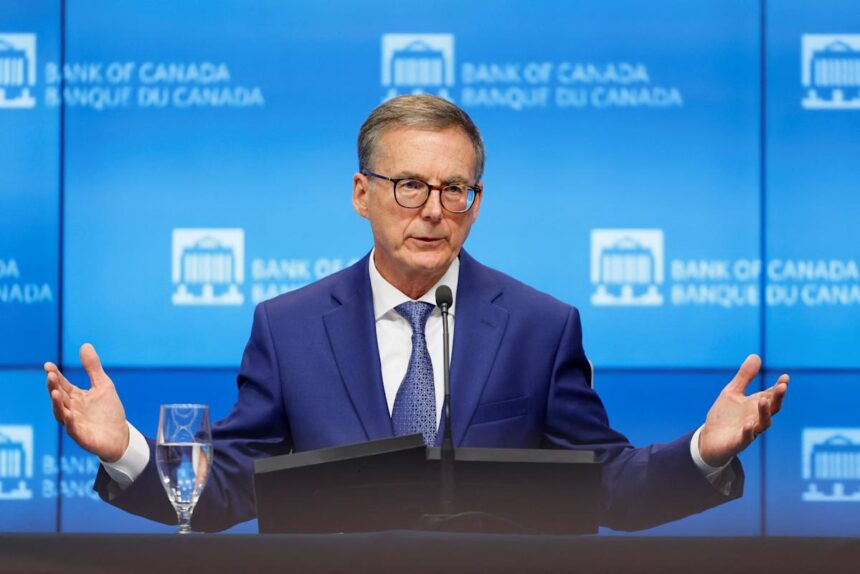The central bank’s rate path remains clouded as economists’ forecasts split between aggressive cuts and cautious holds. What’s driving this uncertainty, and what should Canadians prepare for?
When Bank of Canada Governor Tiff Macklem delivered his first interest rate cut in June, ending a nearly year-long holding pattern at 5%, many Canadians exhaled in collective relief. The long-awaited pivot suggested we’d turned a corner on inflation after the most aggressive tightening cycle in a generation. Yet here we are, months later, and economists can’t seem to agree on what comes next.
TD Economics sees another 100 basis points of cuts by mid-2025. RBC believes we’ll get 75 basis points of easing by spring. Meanwhile, Desjardins anticipates a total of 225 basis points in cuts by the end of next year. These aren’t minor variations—they represent fundamentally different views about where our economy is heading.
“The divergence in forecasts reflects genuine uncertainty, not just analytical differences,” explains Avery Shenfeld, Chief Economist at CIBC Capital Markets. “We’re navigating uncharted waters with conflicting signals from the labour market, consumer spending, and inflation metrics.”
This uncertainty stems from Canada’s complex economic picture. July’s inflation reading held steady at 2.9%—still above the Bank’s 2% target, yet the labour market has softened considerably with unemployment climbing to 6.4% in August. This creates a tension between the Bank’s inflation mandate and growing concerns about economic fragility.
Adding to this complexity is the Canadian consumer’s position. Household debt service ratios have climbed to record levels, yet retail spending has shown surprising resilience in some sectors. This makes predicting the impact of past rate hikes extraordinarily difficult.
“Approximately 60% of fixed-rate mortgages will face renewal at substantially higher rates through 2025,” notes Benjamin Tal, Deputy Chief Economist at CIBC. “The full impact of the Bank’s previous hikes is still working its way through the system.”
The housing market offers another lens into this uncertainty. National home sales ticked up 2.1% in July according to the Canadian Real Estate Association, but prices remain 3.9% below last year’s levels. Real estate professionals report heightened buyer interest following the June rate cut, suggesting pent-up demand could be unleashed with further easing.
“The first cut is always the hardest for central banks,” says Royce Mendes, Managing Director and Head of Macro Strategy at Desjardins. “The Bank of Canada has now crossed that psychological threshold, which typically makes subsequent cuts easier to justify—provided inflation continues moderating.”
What makes this cycle particularly difficult to predict is the global context. The Federal Reserve in the U.S. delivered a supersized 50-basis-point cut in September, creating pressure on the Bank of Canada to follow suit to prevent unwanted Canadian dollar appreciation. Yet domestic economic conditions don’t necessarily warrant matching the Fed’s pace.
“Governor Macklem faces a delicate balancing act,” explains Beata Caranci, Chief Economist at TD Bank Group. “Cut too slowly, and you risk unnecessary economic pain. Cut too quickly, and you might reignite inflation or housing speculation.”
The Bank of Canada itself has maintained a data-dependent stance, offering few concrete signals about its intentions. In its September policy decision, the Bank noted that “excess supply is putting downward pressure on inflation,” but also emphasized that “governing council wants to see continued progress in the easing of underlying inflation.”
This measured language leaves room for various interpretations. Some economists read between the lines to see a central bank preparing for accelerated easing; others see a cautious institution concerned about inflation’s persistence.
For everyday Canadians, these divergent forecasts translate into difficult financial planning. Homebuyers wonder whether to lock in current rates or gamble on further cuts. Business owners must decide whether to expand now or wait for potentially lower borrowing costs. Savers face uncertainty about future returns on their investments.
Stephen Brown, Deputy Chief North America Economist at Capital Economics, offers a framework for navigating this uncertainty: “Rather than trying to predict the exact path of interest rates, Canadians should prepare for multiple scenarios—perhaps by splitting their mortgage between fixed and variable rates or maintaining flexible investment positions.”
The consensus among economists, despite their divergent forecasts, is that rates will trend downward over the next 18 months. The debate centers on pace and magnitude, not direction. Most see the Bank’s overnight rate settling between 2.5% and 3.5% by the end of 2025—substantially lower than today’s 4.5%.
For a housing-sensitive economy like Canada’s, even this broad agreement offers some guidance. The era of emergency-level interest rates is likely behind us, but the path to normalization remains anything but straightforward.
As one Bay Street economist recently quipped to me over coffee: “If you’re looking for certainty in today’s economy, you’re in the wrong business.” Perhaps that’s the most honest forecast of all.






